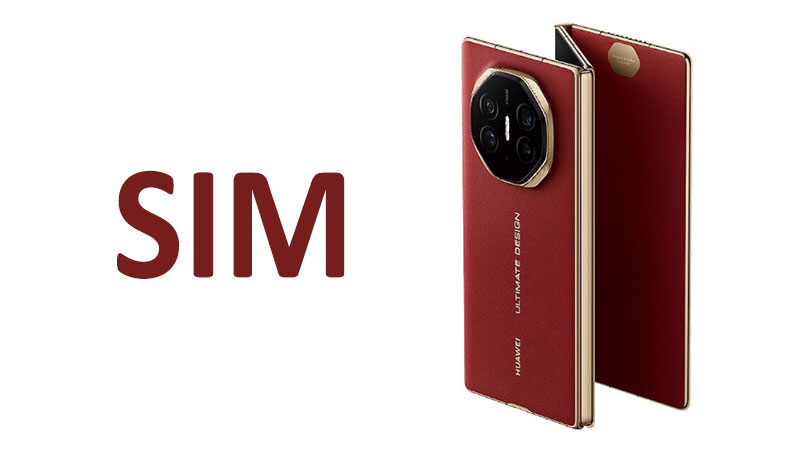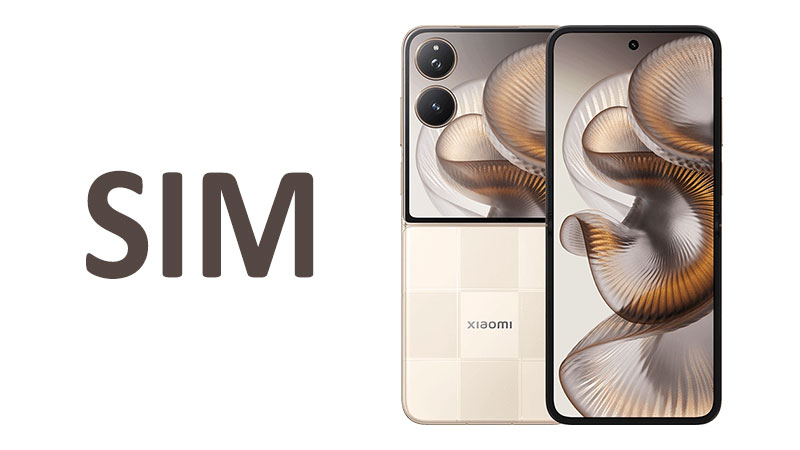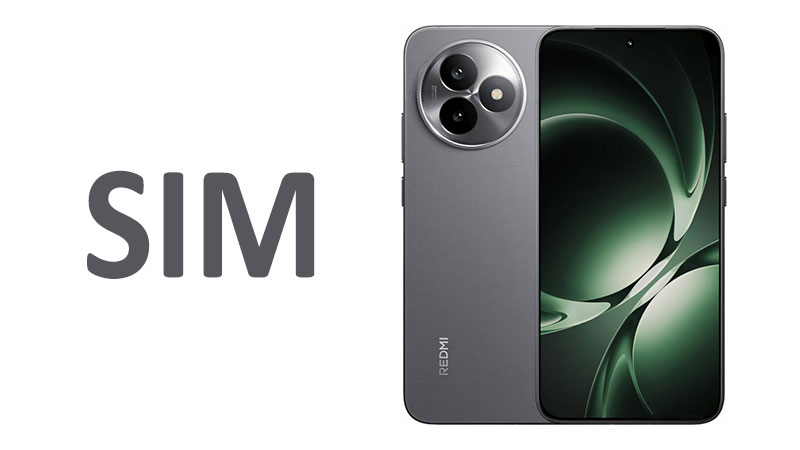The Huawei Mate XTs Ultimate SIM configuration defines the pinnacle of physical dual-line mobile integration. This premium foldable smartphone delivers an uncompromising set of connectivity features. It merges traditional physical dual-SIM capability with advanced wireless standards. The Mate XTs Ultimate is specifically engineered for professional global users. These users demand absolute reliability and maximum throughput. This extensive guide details every aspect of its connectivity suite. We will analyze the phone’s unique Nano-SIM structure and cutting-edge wireless technology. We cover everything from 5G to Wi-Fi 7 to advanced positioning systems. This information is essential for serious buyers.
Dual-SIM Focus: The Classic Nano-SIM Architecture
The Huawei Mate XTs Ultimate utilizes a strictly physical Dual-SIM design. It features a Nano-SIM + Nano-SIM setup. This choice offers robust, traditional reliability. It provides simultaneous operation of two independent mobile accounts. The phone is engineered to manage both lines seamlessly. This configuration strongly appeals to users who prioritize physical security and clear separation.
The Dedicated Dual Nano-SIM Commitment
This specific configuration requires two physical Nano-SIM cards. The Mate XTs Ultimate provides dedicated slots for both cards. This allows the user to maintain two active telephone numbers. They can receive calls and messages on both lines continuously. Crucially, the system allows easy assignment of one SIM for voice calls. The other SIM can handle the primary high-speed mobile data connection. This flexibility helps users maximize cost efficiency and coverage.
The rigid adherence to physical Nano-SIMs is a deliberate design choice. It reflects a preference for reliable, hardware-based line management. Many professional users trust physical cards more than digital alternatives. This setup avoids the reliance on carrier-specific digital provisioning. It offers a standardized solution globally. This is a key feature for the phone’s targeted high-end business audience.
Specialized Comparison: Nano-SIM vs. eSIM
The current industry trend heavily favors eSIM technology. Competitors often offer a hybrid Nano-SIM + eSIM configuration. However, the Mate XTs Ultimate skips the eSIM entirely. It commits to the Nano-SIM + Nano-SIM standard instead. This offers superior simplicity for physical management. Users can easily swap cards when traveling internationally. This is often faster than dealing with complex digital provisioning processes.
The primary difference lies in flexibility versus security. eSIM offers digital convenience and space saving. The dual Nano-SIM setup offers undeniable physical reliability. It ensures the user maintains control over the card itself. Previous Huawei foldable models also favored physical SIMs. This continues the brand’s commitment to hardware-centric solutions.
Pros and Cons of the Physical Dual-SIM
The advantages are rooted in simplicity and control. Physical cards offer easier setup without complex carrier activation steps. Swapping a physical SIM takes only seconds with the right tool. This is excellent for frequent, short-term international trips. It provides reliable backup functionality as well.
The primary downside is the lack of eSIM convenience. Users cannot store multiple inactive international profiles digitally. This requires keeping track of small physical cards when traveling. It also means the SIM tray takes up slightly more internal space. This is a minor structural consideration in a large foldable phone design.
Important Points for SIM Buyers
Buyers must understand this phone requires two physical cards for dual functionality. There is no digital eSIM option. This makes the phone ideal for users with two permanent lines. It suits professionals who rely on secure, tangible SIM authentication. Verify your carrier uses the Nano-SIM format. This remains the industry standard.
Unrestricted Mobile Networking: 5G and Global Technology Access
The Huawei Mate XTs Ultimate supports a vast range of cellular technologies. This ensures maximum global compatibility and speed. It integrates GSM, CDMA, HSPA, CDMA2000, LTE, and high-speed 5G. This is one of the most comprehensive network stacks available today.
The Power of Integrated 5G and LTE
The phone’s primary focus is on delivering industry-leading 5G connectivity. 5G provides significantly higher data rates than any previous standard. It also drastically reduces the end-to-end network latency. Low latency is crucial for demanding applications. These include real-time cloud computing and high-definition video conferencing. The Mate XTs Ultimate is optimized to handle massive data loads effortlessly.
Robust LTE (4G) support maintains continuous service. The device seamlessly transitions between 5G and 4G networks. This ensures uninterrupted connectivity even in less developed areas. Advanced LTE features like carrier aggregation are standard. These features combine multiple channels for faster 4G speeds.
Specialized Comparison: CDMA and Global Band Support
The inclusion of both CDMA and CDMA2000 is a key differentiator. Many contemporary global flagships omit these legacy US standards. Huawei’s comprehensive modem ensures full compatibility with all major US carriers. This broad support is critical for maximizing the phone’s global market appeal. Furthermore, the modem supports a massive array of global frequency bands. This guarantees high-performance 5G access worldwide. This global reach surpasses many regional-specific devices.
Pros and Cons of Network Technology
The immense benefit is universal coverage and speed. The Mate XTs Ultimate can connect to virtually any mobile network on the planet. Its 5G capabilities future-proof the device for years to come. The simultaneous support for multiple network standards maximizes reliability.
The drawbacks are negligible regarding technology. Users should simply confirm compatibility with specific regional frequency bands. This is necessary before traveling to highly specific, isolated locations. The phone is designed to perform at peak speed everywhere else.
Next-Level Wireless Speed: Wi-Fi 7 and Dual-Band Mastery
The Huawei Mate XTs Ultimate incorporates the absolute latest in wireless networking. It includes support for Wi-Fi 802.11 a/b/g/n/ac/6/7. This impressive suite covers every generation up to the cutting-edge Wi-Fi 7 standard. The phone operates as a dual-band device.
The Revolutionary Leap to Wi-Fi 7 (802.11be)
Wi-Fi 7 represents a paradigm shift in local wireless speed. It is engineered for unprecedented data throughput. Theoretical speeds can reach many gigabits per second. The key technology is Multi-Link Operation (MLO). MLO allows the phone to use multiple frequency bands simultaneously. This effectively combines the 2.4 GHz and 5 GHz signals into one massive pipe. This connection method minimizes latency to negligible levels. It drastically increases bandwidth for local networking. Wi-Fi 7 is indispensable for fast local data syncing. It is also required for latency-sensitive activities like cloud gaming.
Understanding Dual-Band Operation
The phone is classified as a dual-band device. This means it operates on the 2.4 GHz and 5 GHz frequency bands. The 2.4 GHz band provides maximum range and better wall penetration. The 5 GHz band offers faster speeds over shorter distances. The phone intelligently selects the optimal band. This provides the best balance of range and speed automatically.
It is important to note the dual-band status. Some newer devices utilize a tri-band system. Tri-band includes the less-congested 6 GHz band (Wi-Fi 6e/7). While the phone supports Wi-Fi 7, its current implementation focuses on the 2.4 GHz and 5 GHz bands. This ensures compatibility with the widest range of existing routers.
Specialized Comparison: Wi-Fi 7 vs. Wi-Fi 6
The inclusion of Wi-Fi 7 gives the Mate XTs Ultimate a significant long-term advantage. Most current devices are limited to Wi-Fi 6. Wi-Fi 7 offers MLO and much higher data rates. This provides a clear path for future performance upgrades. When paired with a new Wi-Fi 7 router, the speed differential is immense. The phone is fully ready for next-generation smart home systems. This is a critical investment in future wireless infrastructure.
Pros and Cons of WLAN Implementation
The greatest advantage is the future-proofing offered by Wi-Fi 7. Users are prepared for the fastest home network speeds available. The comprehensive backward compatibility ensures connection to any older router. This maintains excellent connection reliability across all standards.
The main drawback is the dual-band limitation. The phone does not utilize the dedicated, clean 6 GHz band. This band is available in many Wi-Fi 6e or tri-band Wi-Fi 7 implementations. Congestion on the 5 GHz band could affect performance in very crowded wireless areas. The phone compensates with the MLO capability of Wi-Fi 7.
Elite Audio and Short-Range: Bluetooth 5.2 and L2HC Codec
The Huawei Mate XTs Ultimate uses the highly capable Bluetooth 5.2 standard. This manages all short-range wireless peripheral connections. It is fully optimized for efficient data transfer and battery conservation. This version handles all connections for smartwatches, cars, and audio devices.
Decoding Bluetooth 5.2 and L2HC Audio
Bluetooth 5.2 provides excellent stability and improved power management. It includes support for LE (Low Energy) Audio standards. This ensures compatibility with future efficient audio accessories. The standout feature is the inclusion of the L2HC audio codec. L2HC is Huawei’s proprietary high-definition audio transmission technology. It supports exceptionally high bitrates for wireless audio.
The L2HC codec is designed for audiophile-grade sound quality. It delivers near-lossless audio transmission. This requires pairing the Mate XTs Ultimate with compatible high-end Huawei headphones. This combination provides a wireless listening experience that rivals wired connections. This focuses heavily on the premium audio experience.
Specialized Comparison: L2HC vs. Other High-Res Codecs
Many competitors rely on codecs like aptX HD or LDAC. L2HC often provides a higher effective bitrate than these alternatives. This translates directly to superior sound detail and clarity. Bluetooth 5.2 is slightly older than the latest 5.4 version. However, the L2HC codec offers a more impactful performance difference. It caters directly to the demanding audio enthusiast market. This provides a specialized, high-fidelity experience.
Pros and Cons of Bluetooth Implementation
The major advantage is the inclusion of the elite L2HC audio codec. This guarantees the absolute best wireless audio quality possible. Bluetooth 5.2 itself is highly stable. It offers excellent power efficiency for connected accessories.
The constraint is codec compatibility. L2HC only works with specific Huawei audio accessories. Users must purchase these compatible devices to realize the full high-definition audio potential. Standard accessories will still work perfectly with standard Bluetooth codecs.
Hyper-Accurate Positioning: Multi-Frequency GNSS System
Precision location services are a standout feature of the Huawei Mate XTs Ultimate. The phone boasts one of the world’s most advanced GNSS suites. It supports an unprecedented number of systems and frequencies concurrently. This ensures centimeter-level accuracy for every location request.
The Power of Multi-Frequency GNSS
The phone supports GPS, GLONASS, BDS, GALILEO, QZSS, and NavIC. The key is the multi-frequency reception.
- GPS uses both L1 and the robust L5 civilian signal.
- BDS uses an astounding four different frequencies (B1I+B1c+B2a+B2b).
- GALILEO utilizes three frequencies (E1+E5a+E5b).
Simultaneous reception across these multiple frequencies is revolutionary. It dramatically reduces errors caused by atmospheric delays and signal blockage. The phone achieves instant, highly stable location locks. This hyper-accuracy is vital for professional mapping applications. It is also necessary for advanced augmented reality experiences.
Specialized Comparison: Four-Frequency BDS Support
No other consumer smartphone offers four-frequency support for the BeiDou System (BDS). This level of dedication to precision is unparalleled. It is particularly important for performance in the Asia-Pacific region. The inclusion of NavIC, India’s regional system, on the L5 band adds further global redundancy. The Mate XTs Ultimate offers the most technically advanced and accurate positioning system available. This significantly outperforms standard dual-frequency flagship systems.
Essential Points for High-Precision Users
The advanced GNSS is not just for casual navigation. Users in demanding fields should note this feature. These include geology, precise surveying, and high-fidelity drone piloting. The phone provides a portable, highly accurate positioning tool. This robust system is an often-overlooked flagship feature. It provides unparalleled reliability in challenging environments.
Wired and Auxiliary Utility: USB 3.1 and Infrared Port
The Huawei Mate XTs Ultimate is complete with robust physical connections and auxiliary features. These components deliver significant practical utility. They ensure the device functions as a versatile tool.
High-Speed USB Type-C 3.1 with DisplayPort 1.2
The Mate XTs Ultimate features a USB Type-C 3.1 port. This provides substantially faster data transfer speeds than common USB 2.0 ports. It facilitates quick file transfer. Moving massive video files from the phone to a computer takes only seconds.
The port supports DisplayPort 1.2 functionality. This allows the phone to output high-resolution video directly to an external screen. Users can connect the foldable to a monitor for a full desktop experience. This enhances productivity significantly. The port also supports On-The-Go (OTG). OTG allows for direct connection to peripherals. These include external storage drives and professional input devices. This capability makes the phone a true portable workstation.
Specialized Comparison: USB 3.1 vs. USB 4.0
USB Type-C 3.1 is highly capable. However, it is slightly slower than the newest USB 4.0 standard. USB 4.0 offers even higher potential speeds. For most daily tasks, USB 3.1 provides more than enough bandwidth. The inclusion of DisplayPort 1.2 is the key utility feature. This makes the port highly functional, despite the minor speed difference from the very latest standard.
NFC and Infrared Port Utility
Near Field Communication (NFC) is included for seamless transactions. NFC enables fast, secure, contactless mobile payments. Users can link their bank cards easily. They can then tap the phone to pay at compatible terminals globally. This streamlines all daily financial exchanges efficiently.
The phone also retains the highly convenient infrared port (IR blaster). This feature transforms the Mate XTs Ultimate into a universal remote control. Users can control various home electronics instantly. This includes televisions, air conditioners, and stereos. The IR port is a practical addition that many competing flagships omit. It adds unique convenience for managing the smart home environment.
The Absence of an FM Radio Tuner
The specifications confirm the device does not include an integrated FM radio tuner. This exclusion is standard across almost all modern high-end phones. Consumers rely on data connections for digital streaming of radio and music. The phone’s lightning-fast 5G and Wi-Fi 7 connectivity handle all streaming needs flawlessly.
Comprehensive Connectivity Summary for Buyers
The Huawei Mate XTs Ultimate connectivity is built for the highest performance. It maximizes utility for professional users globally. This feature set strongly justifies the foldable’s premium price.
Key Connectivity Advantages
- Dedicated Dual Nano-SIM: This setup provides reliable, secure physical line management for two numbers.
- Future-Ready Wi-Fi 7: This ensures access to the fastest potential local network speeds available.
- Hyper-Precision GNSS: Multi-frequency support across six systems delivers unmatched global location accuracy.
- Elite Bluetooth Audio: The L2HC codec provides superior, high-definition wireless sound quality.
- Professional USB 3.1: The port allows high-speed data transfer. DisplayPort 1.2 support enables external monitor output.
- Infrared Port: The IR blaster adds unique convenience for universal remote control functionality.
Key Connectivity Trade-offs
- No eSIM Support: Users lack the digital flexibility of storing multiple virtual SIM profiles.
- Dual-Band Only WLAN: The phone does not utilize the cleaner, less congested 6 GHz band.
- Bluetooth 5.2: This is an older standard compared to the latest 5.4 version.
Final Buyer Considerations
The Mate XTs Ultimate is ideal for professionals who need physical dual-SIM reliability. It is perfect for users who prioritize the highest possible audio quality via L2HC. The phone is also unmatched for those needing centimeter-level positioning accuracy. Buyers must accept the trade-off of no eSIM. They must be prepared to use physical SIM cards exclusively. Overall, this device offers a specialized, high-performance connectivity array. It is tailored for the most demanding global users.
Conclusion: Making the Ultimate Choice
The Huawei Mate XTs Ultimate SIM and connectivity package offers a powerful, specialized solution. It combines the security of a physical Dual Nano-SIM with extreme digital speed. The inclusion of 5G, Wi-Fi 7, and multi-frequency GNSS is truly exceptional. It ensures the phone is a reliable, future-proof communications hub.
The device excels in niche utility. Features like the L2HC audio codec and the hyper-accurate positioning system stand out. They provide specialized benefits over standard flagships. If you are a professional demanding absolute reliability, speed, and specific high-end utilities, this phone is the definitive choice. The Huawei Mate XTs Ultimate delivers an ultimate, uncompromising connectivity experience.
Frequently Asked Questions (FAQ)
1. Does the Huawei Mate XTs Ultimate support digital eSIM technology?
No, the Mate XTs Ultimate uses a traditional Nano-SIM + Nano-SIM setup. It does not support any digital eSIM functionality.
2. Is the Bluetooth 5.2 standard fast enough for high-quality audio streaming?
Yes, Bluetooth 5.2 is highly stable and efficient. The inclusion of the L2HC codec ensures it supports extremely high-definition audio transmission to compatible headphones.
3. What is the benefit of the phone’s multi-frequency GNSS support?
Multi-frequency GNSS uses multiple satellite signals simultaneously. This method significantly increases location accuracy. It minimizes errors caused by atmospheric interference and signal blockages.
4. Can the phone’s USB Type-C 3.1 port connect to an external monitor?
Yes, the USB Type-C 3.1 port includes DisplayPort 1.2 support. This allows the phone to output high-resolution video directly to external displays or monitors.
5. Will the Wi-Fi 7 feature work without a special router?
The phone will connect to all older Wi-Fi networks perfectly. However, the full, maximum speed potential of Wi-Fi 7 requires pairing it with a compatible Wi-Fi 7 router.



